 Leading Blog | Posts by Month |
 Leading Blog | Posts by Month |
01.31.18

LeadershipNow 140: January 2018 Compilation
See more on
Posted by Michael McKinney at 05:37 PM
01.26.18

A Dozen Lessons for Entrepreneurs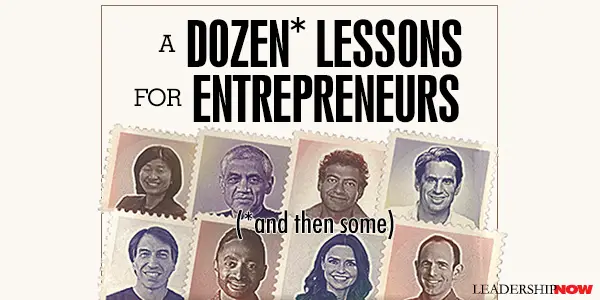
T For A Dozen Lessons for Entrepreneurs, Griffin has interviewed 35 people who have “seen more highly successful business launched than any other single group on the planet.” He offers 12 quotes from each followed by short explanations to provide clarity and context. The book is a real education that is worth taking the time to reflect on and absorb. You will get an experiential education from investors like Steve Blank, Marc Andreessen, Mary Meeker, Paul Graham, John Doerr, and Ben Horowitz. What follows are some of the thoughts that resonated with me: Eric Ries: “The mistake isn’t releasing something bad. The mistake is to launch it and get PR people involved. You don’t want people to start amping up expectations for an early version of your product. The best entrepreneurship happens in low-stakes environments where no one is paying attention, like Mark Zuckerberg’s dorm room at Harvard.” (p. 36) Sam Altman: “In general, it’s best if you’re building something that you need. You’ll understand it better than if you have to understand it by talking to a customer. Passion and a mission are more likely to exist if a business is providing solutions to problems that cause the founders personal pain. In other words, a deep understanding of a valuable customer problem and potential solutions to that problem is enhanced if the founders are themselves potential customers for the solution.” (p. 44) Sam Altman: “Eliminate distractions. The hard part of running a business is that there are a hundred things that you could be doing, and only five of those matter, and only one of them matters more than all of the rest of them combined.” (p. 48) Steve Anderson: “Ten years ago, you needed $5 million to start a business. Today, you need $70 and some coding skills.” (p. 53) Rich Barton: “It’s much more powerful long-term to make up a new word than it is to use a literal word. I also like to high-point Scrabble letters in my brands if I can work them in. They are high point because they are rarely used. A letter that’s is rarely used is very memorable. Z and Q are all worth ten points in Scrabble. X is 8. They jump off the page when you read them, and they stick in your memory as interesting.” (p. 73) Chris Dixon: “You’ve either started a company or you haven’t. “Started” means starting with no money, no help, no one who believes in you (except perhaps your closest friends and family), and building an organization from a borrowed cubicle with credit card debt and nowhere to seep except the office. It means lying awake at night worrying about running out of cash and having a constant know in your stomach during the day fearing you’ll disappoint the few people who believed in you and validate your smug doubters.” (p. 99) John Doerr: “Believe me; selling is honorable work—particularly in a startup, where it’s the difference between life and death.” (p. 102) Jim Goetz: Many of the entrepreneurs that we back are attacking a personal pain.” (p. 116) Paul Graham: “If you want to start a startup, you’re probably going to have to think of something fairly novel. A startup has to make something it can deliver to a large market, and ideas of that type are so valuable that all the obvious ones are taken. Usually, successful startups happen because the founders are sufficiently different from other people—ideas few others can see seem obvious to them.” (pp. 126-127) Reid Hoffman: “So many entrepreneurs are worried about protecting their precious ideas, but the truly valuable thing is that you’re in motion, you have momentum, and you are gathering all the necessary resources to make it happen.” (p. 158) Reid Hoffman: “The network of people around you I what extends your ability to be effective regarding expertise and reaching your goals. Put yourself out there and get feedback. Don’t be afraid to take a risk. Another huge thing to emphasize is the importance of your network. Get to know smart people. Talk to them. Stay current on what’s happening. People see things that other people don’t. If you try to analyze it all yourself, you miss things. Talk with people about what’s going on.” (pp. 160-161) Ben Horowitz: “Sometimes an organization doesn’t need a solution; it just needs clarity.” (p. 168) Vinod Khosla: “The single most important thing an entrepreneur needs to learn is whom to take advice from and on what topic. Ask different questions of different people, both those who have been successful and those who haven’t.” (p. 179) Keith Rabois: “As you get into the unchartered territory where you don’t actually have any intellectual background, you need perspectives from people who are very different from you. At that point, it’s actually quite valuable to have people who are diverse.” (p. 255) Keith Rabois: “First Principle: The team you build is the company you build.” (p. 254) Fred Wilson: “Reputation is the magnet that brings opportunities to you time and time again. I have found that being nice builds your reputation.” (p.302) 
Posted by Michael McKinney at 06:11 AM
01.24.18

The Power of Vulnerability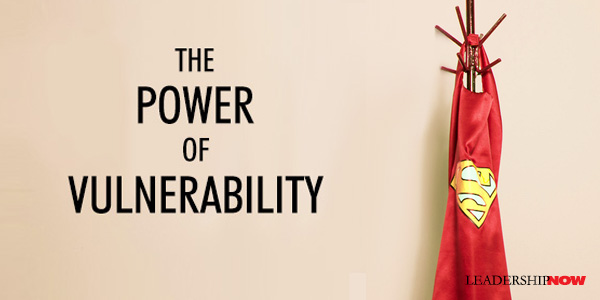
H In The Power of Vulnerability, Barry Kaplan and Jeffrey Manchester explain that the secret to unleashing the power of leaders, teams, and organizations, is through vulnerability. The more that leaders open their hearts, reveal their fears and show their authentic selves, the deeper the connections among team members will be, and the more the team will achieve. Part of what makes it work is that when we get behind the façades that we habitually put up, we begin to understand others better—their motivations, values, and beliefs. As we better understand what is going on inside of us, we will better understand what is going on inside of others and take their comments and behaviors less personally. We will begin to understand their points of view more completely. It generates respect and a willingness to share points of view that can strengthen the group as a whole. You don’t begin this journey to authenticity and vulnerability by giving away the store. There are real and imagined risks. Some environments carry more risk than others. “Imagine that there is a continuum of risk, on one end of the spectrum is where you shut down completely, and at the other end, you are wide open. You stand somewhere along that continuum as you subjectivity determine what’s what. That’s your spot of safety, where your internal risk manager allows you to play.” To take the first step, “you’ll need to get permission from your internal risk manager to take a small step, say to stretch just 10 percent, in showing vulnerability.” If you don’t believe it’s safe enough for you to share your opinions, you are not going to. Yet because you have clarity about what you want, you can now imagine the relational and team dynamics to ensure that you can express yourself more fully. Because you have clarity about your need to create safety, it’s already safer. As you also make it safe for others to show their vulnerabilities, it will become safer for you. Creating a safe space for others involves: 1. Getting Present: Set aside distractions. While you may feel safe in being disconnected, “if you’re going to be more open and vulnerable and show up in your power, then you must first shift from disconnection to the intentional practice of connection.” The authors suggest checking yourself mentally, emotionally, physically and spiritually. Where are you right now through these four energy centers? 2. Understanding and Committing to Guidelines and a Protocol for How We Are Going to Connect: For example, everyone commits to respect confidentiality, being present in the moment, staying when times get tough, speaking the truth, asking for what you want, owning your judgments and feelings, actively listening, and asking permission before offering feedback or advice. 3. Using the “Clearing and Resolution Model:” Clear the elephants in the room so that “everyone can be aligned with themselves and the people they work with.” There is a process of clearing that asks five questions; What are the facts? What are your perspectives? What are you feeling? What was your role in attracting the issue to you? What do you want specifically? 4. Completing Exercises to Take Steps Toward Authenticity: Break the ice with an exercise like everyone sharing a bit of themselves to get you to move out of your head to opening up emotionally to become more present. Create shared experiences. “The weekly or monthly meetings don’t count because the primary focus in those sessions is on the business of the company. Additional investment on a quarterly, semi-annual, and, at a minimum, annual offsite is required to help continue the momentum of trust and connection that has been established.” 5. Anchoring and Integrating the Process: Create a rhythm by creating rituals that serve to maintain the connection you’ve established. The heart of authenticity is connection. It has to be a conscious choice practiced over and over.
Begin the journey by practicing vulnerability in the hope that others on your team will really see you and seek a version of the journey for themselves. And hang up the cape.

Posted by Michael McKinney at 10:50 AM
01.22.18

Killing It! How to Run a Startup in a Healthy, Joyful Way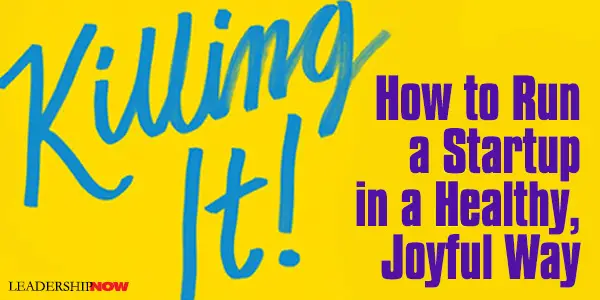
A Entrepreneurship has never seemed so popular as it is today no doubt because it is easier than ever to start a company. Especially in the tech sector, barriers to entry have fallen, and there is greater access to risk capital for startups. Steve Anderson, the founder of Baseline Ventures, said, “Ten years ago, you needed $5 million to start a business. Today, you need $70 and some coding skills.” It is a golden age for entrepreneurs. But with the implied success is a dark side that is rarely talked about. The cost is often the entrepreneur’s physical and mental health and the impact their work has on their family and friends. Sheryl O'Loughlin tackles this head-on in Killing It! The entrepreneur’s personal life is often the hidden cost of building an uber-successful career or business. Sheryl who has taught entrepreneurship at the Stanford Graduate School of Business understands the ups and downs of being an entrepreneur. She served as the CEO of Clif Bar, was the Co-Founder and CEO of Plum Organics and is now CEO of REBBL. In Killing It! she offers empathetic support for entrepreneurs with candid discussions about her own experience and those of other entrepreneurs she has known. Many people start a business without really knowing what they are getting into. Starting a business for money is a bad bet since around 95 percent of startups fail. There needs to be a real love for the problem you’re trying to solve. Professor, social entrepreneur and investor Will Rosenzweig, told Sheryl, “Many thought they were going to launch a business coming out of school, not necessarily to solve a problem, but the problem they were trying to solve was their own unemployment and livelihood.” Execution Once you get past the idea, execution is everything. “It’s this build phase that catches many entrepreneurs by surprise—after so much excitement; they’re shocked at how mundane it all is. Remember the Buddhist saying, ‘After enlightenment, the laundry.’ Oh, and how much laundry there is.” Sheryl says you have to make others love your business as well and connect to the company’s purpose—and it’s ongoing. You do that by inviting others to be part of the story. You help others to connect their personal passions to the company’s purpose. You and your team need to live the experience your customers have with the product. You need to be a leader that models love, compassion and care and hire people that can do the same. At the same time, love can blind you to realities. So “let reality in,” she cautions. “You don’t have to love every moment, but you do have to love enough of them.” Entrepreneurs believe they have to do it all. Show no weakness. But we do have weaknesses. We need to talk to each other. “When entrepreneurs don’t rely on one another, they don’t harness the power of possibility. Too often we approach our work from a mind-set of scarcity and not one of abundance—a mistake that holds us back. The entrepreneurial profession requires that a person be vulnerable in order to remain healthy, and it’s critical to have a space in your life with others that allows for that.” When it comes to running your own company, business and personal issues are all intertwined. Friendships Hang on to your friends. “Friendships are crucial for the emotional well-being of an entrepreneur, but they are often the first thing to hit the chopping block when things get busy.” There are three good reasons for this:
Risk-Taking I’ve risked it all is not a good strategy. “A skilled entrepreneur is the one who will assign risk to somebody else. The entrepreneur will that the resources when they are there. Would you go climbing without the proper gear? Probably not, and you shouldn’t approach business any differently. Entrepreneurship is about minimizing risk.” You need a Plan B because most of the time you will need it. Most ventures will fail. “You can’t make the mistake of thinking you’ll beat the odds just because you have a fancy degree, stellar experience, and great contacts.” Self-Worth We are conditioned to believe that money equals success. It’s vital, but your self-worth isn’t tied to the company’s net worth. “To keep a healthy self-worth/net worth separation, you have to continually ask yourself what role money is serving in your endeavor? Is money becoming your identity?” What are you proud of? We talk about family values, but they aren’t as easy to measure as money. Your self-worth is probably the most important message of her book. Self-worth “is the quality that must be the strongest and most fight-ready before you start a company.” No matter what happens, you are not the company. “What must endure is a deep feeling that you are living in line with your values, that you are fundamentally grounded. You have to have resilience, and you have to know that you can fall down, get back up, and wipe yourself off, aware that deep down you are okay. Without this strong sense of self-worth, no matter how supportive your partner or your kids or your friends, no matter how bold or humble you are, you are at risk, even if your company isn’t.” Most new businesses fail. And most entrepreneurs would do it all over again. But if you know up front the dark side of entrepreneurship, hopefully, the journey will end up happier and healthier for you. Before you start a company, think of entrepreneurship in terms of your life as a whole. Invest in your wellbeing. Killing It! is a great place to start. 
Posted by Michael McKinney at 03:39 PM
01.19.18

6 Characteristics of Type R People
W Ama and Stephanie Marston describe what is needed to leverage change and hardship into opportunity as individuals and organizations and carry that progress into the world in the form of a contribution to the greater good in Type R: Transformative Resilience for Thriving in a Turbulent World. Those who flourish in this world don't just have resilience, they have Transformative Resilience: the ability to learn, grow, and spring forward. These are people they refer to as Type Rs. Transformative Resilience frames challenge as an opportunity rather than a problem. It leads to new approaches and questions about how to best address an issue. It asks, What other doors might open for me? What other things might I do? What changes do I need to make? It isn’t simply what happens to us, but how we respond to what happens that has the greatest effect on the trajectory of our lives after adversity. The world is uncertain, but the “certainty we seek is that we have the inner resources to transcend our challenges and in fact be transformed by them.” Having the Type R mindset and characteristics act as a shock absorber that enables people and organizations to cope with the day-to-day stress as well as the seismic events.” Regardless of our age or background, if we think of ourselves as adaptable, confident, robust, and able to continue to grow, we will spring forward from stress and challenges in our lives. The Marston’s have found six characteristics that reinforce and interact with one another that will help individuals and organizations to cultivate Transformative Resilience. Each one of these six characteristics can be developed and strengthened over time and when thoughtfully engaged, will take us to the opportunity beyond the challenge. 1. Adaptability Adaptability is the tension between “knowing when to hold firm and when to accept the changing world around us and alter our outlook, goals, and plans.” As our world becomes more uncertain, we tend to look back to the good-ol’-days for support, but this can make us resistant to change. Knowing what you can and cannot change and when to adapt and reframe to find positive outcomes, is a critical skill in today’s world. 2. Healthy Relationship to Control Closely linked to adaptability is having a healthy relationship to control. This involves having a strong sense of when to exercise control, when to persevere, and when to let go. While believing that everything is outside of our control and nothing that we do matters is unhealthy as it causes us to stagnate, believing that we alone are responsible for what happens to us is only healthy to a point. An extreme internal locus of control can cause us to take on “too much responsibility for ourselves and the world around us” causing undue stress and difficulty “because it doesn’t take into account eternal factors” and cause us to be overly rigid. Type Rs learn to “assess what’s within their sphere of influence and what’s not. They realize that strength isn’t always determined by triumph over the outside world but sometimes by changing our inner world.” 3. Continual Learning An important factor in continual learning is knowing yourself and reflecting on the situations you encounter so that you can extract the all the lessons you can to better prepare you for future challenges. Type Rs should always be aware of what is going on in their world so that they can learn and adapt in anticipation of coming challenges rather than having to react to them. Curiosity “is vital to adaptability and intellectual growth, and it motivates ongoing learning and forward motion.” 4. Sense of Purpose Having a sense of purpose is your north star. Regardless of the uncertainty and indecision around you, a sense of purpose grounds you with values to keep you on course and set a direction. It also provides you with the means to find meaning in whatever you are going through. Along with the other Type R characteristics, a sense of purpose helps to inspire others through the way we approach each situation. “Type Rs maintain a vision of what truly matters, what their lives and their work are about, and what they want it to be. A sense of purpose provides a buffer against obstacles; a person or group with a strong sense of purpose can more easily remain engaged and satisfied with life or work even while experiencing challenges.” 5. Leveraging Support Don’t go it alone. The Marston’s write that “One of the biggest obstacles to growing from adversity is the sense of being alone.” It is important for building resilience that we have a strong network of people we can count on both personally and professionally. They provide a safety net and a sense of security. They also help to give you time to reflect, create perspective, and think about the challenges you face. “Many of our successes might rise and fall with our ability to leverage support.” 6. Active Engagement Transformative Resilience “takes place when the Type R mindset and its various characteristics and skill are combined with forward motion.” Along with a healthy relationship to control, staying engaged is believing that no matter what happens you have what it takes to deal with the changing and often challenging circumstances in your life. This also means being proactive and confronting the issues rather than avoiding them. Knowing that you have the inner resources to stay engaged helps you to slow down and respond rather than reacting. While challenges are stressful, “research shows that those who focus on the challenging dimension of a stressful circumstance, rather than seeing it as a threat, experience a different form of stress.” This is because, “their fear reaction is suppressed and instead a response linked to hormones and parts of the brain associated with positive emotions and learning are triggered, thus encouraging engagement.”
What’s Your Type R Quotient? Take the Type R assessment. 
Posted by Michael McKinney at 05:14 PM
01.17.18

8 Principles for Building a High-Performance Culture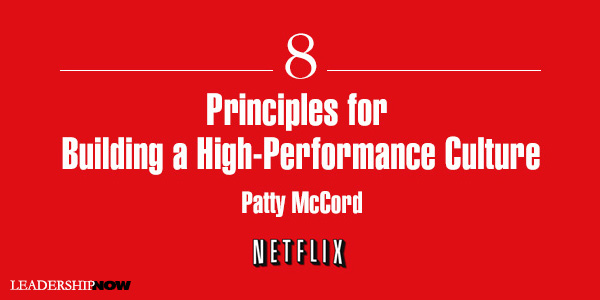
W When McCord began her career in Human Resources at Netflix, she began working with Reed Hastings to identify the behaviors that they wanted to see become consistent practices and worked to instill the discipline of actually doing them. When established they were communicated over and over again and eventually became known as the Netflix Culture Deck. They coached all of their people, at all levels and on all teams, to be disciplined about these fundamental set of behaviors. “A company’s job isn’t to empower people,” she writes, “it’s to remind people that they walk in the door with power and to create the conditions for them to exercise it.” As a leader, you need to model that behavior. If you want people to act like adults, they have to see adult behavior. There are a lot of great insights in Powerful but here are some takeaways for you to think about: 1. Treat People Like Adults “Great teams are made when every single member knows where they’re going and will do anything to get there. Great teams are not created with incentives, procedures, and perks. They are created by hiring talented people who are adults and want nothing more than to tackle a challenge, and then communicating to them, clearly and continuously, about what the challenge is. Saying to employees, “If you do X, you’ll be rewarded with Y,” assumes a static system. Yet no business is static. Being given a great problem to tackle and the right colleagues to tackle it with is the best incentive of all. 2. Communicate Constantly About the Challenge Coming up with simple yet robust ways to explain every aspect of the business isn’t easy, but it pays huge rewards. Don’t hire people that are stupid. Better yet, don’t assume that people are stupid. Assume instead that if they are doing stupid things, they are either uninformed or misinformed. If your people aren’t informed by you, there’s a good chance they’ll be misinformed by others. If you stop any employee, at any level of the company, in the break room or the elevator and ask what are the five most important things the company is working on for the next six months, that person should be able to tell you, rapid-fire, one, two, three, four, five. Ideally using the same words you’ve used in your communications to the staff and, if they’re really good, in the same order. If not, the heartbeat isn’t strong enough yet. 3. Practice Radical Honesty People can handle being told the truth, about both business and their performance. The truth is not only what they need but also what they intensely want. The most important thing about giving feedback is that it must be about behavior, rather than some essentializing characterization of a person, like “You’re unfocused.” It must also be actionable. When leaders not only are open to being wrong but also readily admit it, and when they do so publically, they send a powerful message to their teams: Please speak up! 4. Cultivate strong Opinions and Debate Vigorously Our Netflix executive team was fierce. We were combative in that beautiful, intellectual way where you argue to tease out someone’s viewpoint because although you don’t agree, you think the other person is really smart so you want to understand why they think what they think. “Can you help me understand what leads you to believe that’s true?” We had cultivated the practice of asking people about the nature of problems they were tackling rather than assuming an understanding of them. People become overly wedded to data and too often consider it much too narrowly, removed from the wider business context. They consider it the answer to rather than the basis of good questions. Good judgment: the ability to make good decisions in ambiguous conditions, to dig deeply into the causes of problems, and to think strategically and articulate that thinking. 5. Relentlessly Focus on the Future Leaders rarely look to the future in thinking about the team they’ll need. They tend to focus on what their current team is achieving and how much more that team can do. Another mistake I’ve seen in building teams is assuming that current employees will be able to grow into the responsibilities of the future. This is an especially acute problem for start-ups because founders often feel a strong sense of loyalty to their early team. Are we limited by the team we have not being the team we should have? We were going to make sure our teams were constantly evolving. Just as great sports teams are constantly scouting for new players and culling others from their lineups, our team leaders would need to continually look for talent and reconfigure team makeup. I believe the best advice for all working people today is to stay limber, to keep learning new skills and considering new opportunities, regularly taking on new challenges so that work stays fresh and stretches them. [whether that means rising within the company or seizing a great opportunity elsewhere.] 6. Have the Right Person in Every Single Position At Netflix we had three fundamental tenants to our talent-management philosophy. First, the responsibility for hiring great people, and for determining whether someone should move on, rested primarily with managers. Second, for every job, we tried to hire a person who would be a great fit, not just adequate. Finally, we would be willing to say goodbye to even very good people of their skills no longer matched the work we needed done. People’s happiness in their work is not about gourmet salads or sleeping pods or foosball tables. True and abiding happiness in work comes from being deeply engaged in solving a problem with talented people you know are also deeply engaged in solving it, and from knowing that the customer loves the product or service you all have worked so hard to make. 7. Pay People What They’re worth to You Separate performance review and compensation systems. The tight bind between the performance review process and salary increase and bonus calculations is one of the main factors holding companies back from doing away with the review process. I realized that his work with us had given him a whole new market value. We realized that for some jobs we were creating our own expertise and scarcity, and rigidly adhering to internal salary ranges could actually be harming our best contributors financially because they could make more elsewhere. 8. Proactively Say Goodbye One of the benefits of the leadership communicating clearly to everyone in the company about where you’re heading and the challenges and opportunities that future will bring is that it better equips people to evaluate how well their skills fit into that future. They can also consider whether or not that future is one they want to be a part of and, if it isn’t, can proactively seek out new opportunities. 
Posted by Michael McKinney at 08:30 PM
01.10.18

How to Avoid the 5 Career Derailers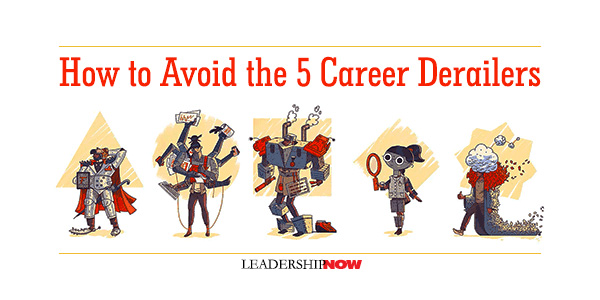
W In The Right—and Wrong—Stuff, Carter Cast shares with us the turning point in his career at PepsiCo. Blissfully unaware of how negative perceptions were shaped, he was stunned when called into his boss’s office, and told he was “unpromotable” because he was obstinate,” “resistant,” and “insubordinate.” More often than not, people get fired, demoted, or plateau not because they lack the “right stuff,” but because they let the “wrong stuff” act out. Cast’s research led him to five defining archetypes. These archetypes are present across all organizations, genders, and levels of seniority. Captain Fantastic
As you progress [in your career], your relationship with others is more important than your knowledge of and relationship with data. This need kicks in as you move into middle and upper management. It’s a mindset change. You have to suppress your ego, let go of having the answer and embrace the relational world. It becomes less about having competencies and more about engendering trust. The Solo Flier
For many talented people “skilled in and rewarded for ‘doing,’ the shift to manager and leader is a hard one. We’re required to operate differently, getting work done through others, moving from athlete to coach. We need to move from ‘me’ to ‘we.’” Version 1.0
Version 1.0’s resist learning new experiences. They lack curiosity preferring the status quo. Agility in your personal learning is the “subtle skill of picking up on cues and changing one’s behavior quickly.” Cast recommends that Version 1.0’s become more approachable. “Some people’s fear of change can be masked as assured arrogance or by being a contrarian. They protect themselves by being rigid and aloof and acting with complete assurance. Then, when challenged with a contrary point of view, they become combative and aggressive, like Captain Fantastic.” The One-Trick Pony
This archetype is not strategic. That is, they lack a holistic understanding of the organization. “People with a strong strategic orientation approach problems from an ‘outside-in’ perspective.” The Whirling Dervish
Whirling Dirvish’s need to be in tune with the steps in “the work flow process—their proper sequence, how long each will take to complete, and whom to include along the way.” This includes being able to plan and prioritize tasks before a project is started. Say no when you have to and delegate task to keep things moving. Having the Right Stuff To avoid derailing, you must learn to lead yourself first. We all come close to derailing from time to time, but having the right stuff means that you have the “ability to bounce back, to learn from your mistakes, make adjustments, take corrective actions, and get back on track.” Cast finds that people with the right stuff act on their own initiative, they have emotional intelligence, and have tremendous perseverance and drive for results. And of the three, taking the initiative is the most important. “High performers with the right stuff accelerate their personal and professional development be having a ‘learning orientation’—a curiosity to constantly learn and improve. Avoiding derailing requires that you continuously reflect on your performance. Know where you want to go and understand where you are. Then take steps to bridge the gaps. Cast provides abundant examples of the archetypes and corrective measures for each. We are all a work-in-progress. Carter Cast provides an assessment on his website to find out where your career is vulnerable. 
Posted by Michael McKinney at 11:17 PM
01.04.18

You Unplugged: Prepare to be Spontaneous
M Judith Humphrey writes in Impromptu: Leading in the Moment, that “you must prepare to be spontaneous.” Because we don’t, it’s “not surprising that our daily conversations are often not geared to leadership and our encounters can be less than inspiring.” Interestingly, while the word impromptu is defined as “made or done without previous preparation,” it comes from the Latin in promptu that means “in readiness” or “prepared.” Not surprisingly, jazz musician and professor Stephen Asma wrote in a New York Times opinion piece, “The key to successful improvisation is getting your self out of the way. Usually, the ego tries to coordinate everything, but good improvisers dial down the ego and let the embodied system act, play and respond with reduced ego supervision.” He also states that “the ability to improvise is not just ‘winging it.’ It is built on foundations of study and practice that prepare the improviser for the moment of action.” When visitors lined the streets the night before his famous Gettysburg Address and asked Abraham Lincoln to say a few words, he responded by saying, “I appear before you, fellow-citizens, merely to thank you for this compliment. … I have no speech to make. In my position, it is somewhat important that I should not say any foolish things. The key to influential or leaderful impromptu communication is the right mindset. To be ready for that “moment of action” as Asma put it, Humphrey says the right mindset includes having the intention to lead, being a good listener, and being authentic, focused, and respectful.” To lay the groundwork for impromptu speaking, it is important that you know what you are talking about. You also need to keep your key leadership messages in mind. Your messages should support what you are about. “Whatever your organization, or team, or mission, write down your key message and supporting messages. Burn them in your mind, so you can draw upon them every time you speak. They will be the foundation of your many impromptu scripts.” Humphrey has developed a 4-part scripting template that can be adapted (expanded or contracted) to fit any situation. It is helpful for organizing your thoughts.  First, is the Grabber. This bridge to your audience can be a friendly greeting, reference to a previous discussion, or a segue from someone’s point. Your grabber should not only engage your audience, but it should also bridge to your message. Second, is your Message. This is your point. It is the heart of your impromptu script. It is one idea, engaging, and positive. Third, is the Structure. Create a compelling case for your message with clear, persuasive arguments. Fourth, is the Call to Action. Show how your message can be acted upon. It can be a handoff, or request a decision, give concrete steps, encourage, convey an ultimatum, or inspire collaboration. It motivates. Humphrey’s provides examples of how this can be used in various situations including how it can be expanded and contracted depending on the situation and timing constraints. Malcolm Gladwell explains in Blink that “Improve isn’t random and chaotic at all. It is an art form governed by a series of rules, and [actors] want to make sure that when they’re up onstage, everyone abides by those rules.” “Impromptu speaking,” explains Humphrey’s, “requires the same discipline that the best improvisational actors and jazz musicians use. It, too, is built on a set of rules as well as practice.” Be prepared to lead in any impromptu moment. 
Posted by Michael McKinney at 03:35 PM
01.01.18

First Look: Leadership Books for January 2018Here's a look at some of the best leadership books to be released in January.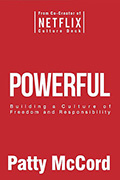    
For bulk orders call 1-800-423-8273  Build your leadership library with these specials on over 39 titles. All titles are at least 40% off the list price and are available only in limited quantities. "A capacity and taste for reading gives access to whatever has already been discovered by others." — Abraham Lincoln
Posted by Michael McKinney at 07:48 AM
|
BUILD YOUR KNOWLEDGE


How to Do Your Start-Up Right STRAIGHT TALK FOR START-UPS 
Grow Your Leadership Skills NEW AND UPCOMING LEADERSHIP BOOKS 
Leadership Minute BITE-SIZE CONCEPTS YOU CAN CHEW ON 
Classic Leadership Books BOOKS TO READ BEFORE YOU LEAD |
|